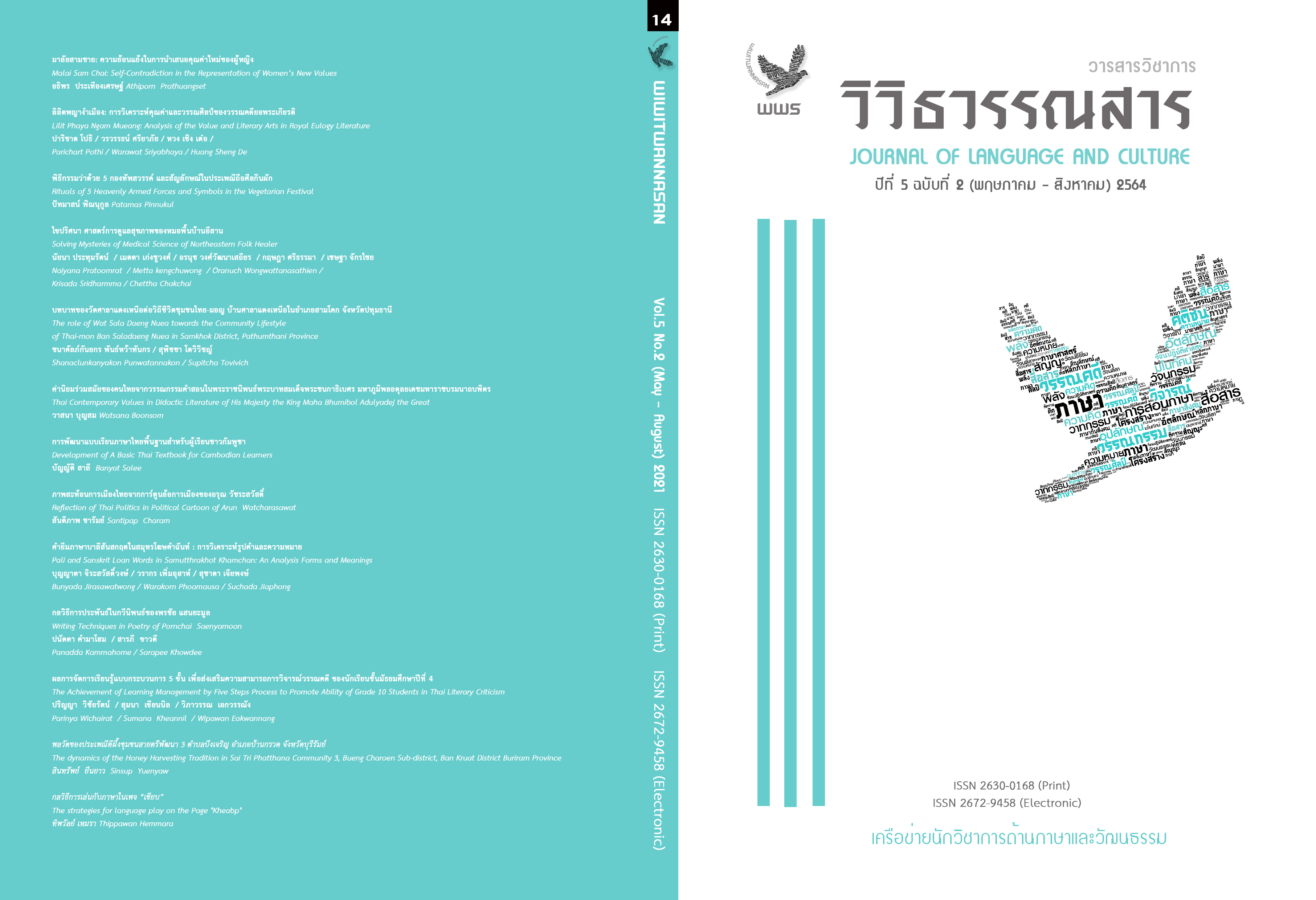กลวิธีการเล่นกับภาษาในเพจ “เขียบ”
Main Article Content
บทคัดย่อ
บทความนี้มีวัตถุประสงค์เพื่อนำเสนอกลวิธีการเล่นกับภาษาในเพจ “เขียบ” จากการศึกษาโพสต์จำนวนทั้งสิ้น 228 โพสต์ ผลการศึกษาพบว่ากลวิธีการสร้างมุกตลกของเพจ พบจำนวน 6 กลุ่ม ได้แก่ 1. การเล่นกับคำพ้อง จำนวน 101 โพสต์ คิดเป็นร้อยละ 44 2. การเล่นกับคำศัพท์ จำนวน 34 โพสต์ คิดเป็นร้อยละ 15 3. การเล่นกับหน่วยเสียง จำนวน 31 โพสต์ คิดเป็นร้อยละ 14 4. การเล่นกับมูลบท จำนวน 27 โพสต์ คิดเป็นร้อยละ 12 5. การเล่นแบบลากเข้าความ จำนวน 25 โพสต์ คิดเป็นร้อยละ 11 และ6. การเล่นกับเอกลักษณ์ของเพจ จำนวน 10 โพสต์ คิดเป็นร้อยละ 4 กลวิธีการเล่นกับภาษาดังกล่าวเป็นการนำเสนอคำศัพท์ภาษาอีสานที่ต้องอาศัยพื้นฐานของความรู้ความเข้าใจในภาษาถิ่นอีสาน กอปรกับความเข้าใจบริบททางสังคมและวัฒนธรรมจึงจะทำให้ผู้อ่านเข้าใจมุกตลกได้ลึกซึ้งยิ่งขึ้น
Article Details
ลิขสิทธิ์ของบทความเป็นของวารสาร การพิมพ์ซ้ำจะต้องได้ร้บการอนุญาตจากบรรณาธิการวารสาร
เอกสารอ้างอิง
โครงการเผยแพร่ผลงานวิชาการ คณะอักษรศาสตร์ จุฬาลงกรณ์มหาวิทยาลัย.
กาญจนา เจริญเกียรติบวร. (2548). การวิเคราะห์วาทกรรมเรื่องตลกภาษาไทย. ปริญญาอักษร ศาสตรดุษฎีบัณฑิต สาขาวิชาภาษาศาสตร์ คณะอักษรศาสตร์ จุฬาลงกรณ์มหาวิทยาลัย.
เดือนเพ็ญ จุ้ยประภา. (2563). คุยกับเพจเขียบ เพจมุกภาษาอีสานเฉียบ ๆ. ค้นเมื่อ 26 กรกฎาคม 2564 จาก https://adaymagazine.com/kheab-page.
ฐานิตย์ เอี่ยมอุตมะ. (2551). กลวิธีและการใช้ภาษาเพื่อสร้างอารมณ์ขันในละครคั่นรายการวาไรตี้เกมโชว์ “ชิงร้อยชิงล้าน”. ปทุมธานี: มหาวิทยาลัยหอการค้าไทย.
บุญเกิด พิมพ์วรเมธากุล. (2545). พจนานุกรมภาษาถิ่นอีสาน (เว่าอีสาน). กรุงเทพฯ: โรงพิมพ์คลังนานาวิทยา.
ราชบัณฑิตยสถาน. (2556). พจนานุกรมฉบับราชบัณฑิตยสถาน พ.ศ.2554. กรุงเทพฯ: ราชบัณฑิตยสถาน.
ศศิวิมล สงวนพงษ์. (2563). อารมณ์ขันในรายการเทยเที่ยวไทย. การค้นกว้าอิสระหลักสูตรอักษรศาสตรมหาบัณฑิต สาขาวิชาภาษาไทย. นครปฐม: มหาวิทยาลัยมหาสารคาม.
สราภรณ์ สุวรรณแสง และรัตนา จันเทาว์. (2559). การสืบทอดภาษาอีสาน. วารสารบัณฑิตศึกษา มนุษยศาสตร์และสังคมศาสตร์ มหาวิทยาลัยขอนแก่น.5(2): 72-88.
หนึ่งฤทัย ชวนะลิขิกร. (2554). อารมณ์ขันในข้อความท้ายรถ: เสน่ห์ของภาษาที่ไม่ควรมองข้าม.วารสารสถาบันวัฒนธรรมและศิลปะ (คณะมนุษยศาสตร์และสังคมศาสตร์) มหาวิทยาลัยศรีนครินทรวิโรฒ.13(1): 69-77.
อติเทพ จันทร์เทศ. (2562). เบื้องหลังแอดมินเพจ “เขียบ”…มุขตลกมาจากมักฟังลำ. ค้นเมื่อ 26 กรกฎาคม 2564 จาก https://theisaanrecord.co/2019/12/04/admin-kiab/.
อ้อมทิพย์ มาลีลัย และประณิตา จันทรประพันธ์. (2563). กลวิธีในการสร้างความขบขันในเพจมุกตลกอีสาน“จอนฟอน”. วารสารมนุษย์กับสังคม คณะมนุษยศาสตร์และสังคมศาสตร์. 5(2): 65-82.
Ross, Alison. (1998). The Language of Humour. London: Routldedge.


